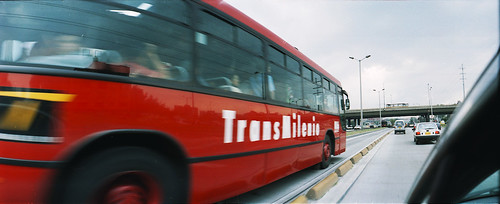For a BRT advocate, it was really exciting to wake up this morning to a front-page, above-the-fold article in the New York Times, with Transmilenio as the central picture. Reading Elisabeth Rosenthal’s article, though, I must say that there were a lot of things that it needed.
I’ll start with the good news, though. That picture is worth each of the 1,262 words of the article. It says it all: dedicated lanes physically separated from the congested roadway, full and permanent stations, large crowds, and special branding. Rosenthal should also be complemented for describing the immense importance of curtailing transportation emissions, the overwhelming success of Transmilenio in terms of gaining riders, reducing emissions and becoming deeply popular, and the spread of BRT across the developing world.
The framing is a mixed bag. It’s an article that focuses almost exclusively on the environmental impact of BRT. I think it’s basically non-controversial that in the short-term (before changing our electricity generation to renewable and ignoring land use), BRT is the most environmentally friendly way of moving people, excluding walking and cycling and it’s good to see the Times publicizing that important finding. That said, an article about transportation and the environment that doesn’t describe land use impact at all is an article that didn’t do its job all the way. I think there’s plenty of evidence that high-quality BRT has promoted TOD in places like Bogota or Curitiba does promote TOD, but that’s a less settled question.
Now, for the inevitable quibbling. The first is the completely silly last paragraph, with the argument that “for the moment the real challenge is overcrowding.” The problem is that too many people use Transmilenio? Now that can’t be right. It’s true, of course, that the system needs to be less crowded, if possible. As Dario Hidalgo, a TheCityFix contributor and much more importantly, the former Deputy General Manager of Transmilenio, told me today, “the ultimate challenge of the bus system will be to prevent the users from shifting to motor vehicles when they have the income to do so. The bus system needs to be comfortable, not just fast, reliable, safe and clean.” But that’s just a question of more money for more buses.
Then there’s the equally silly paragraph just before it, talking about Transmilenio’s “efficient engines.” As Hidalgo reminded me again, these were not particularly clean vehicles. In his words, it wasn’t that “we need these clean buses. We need not-cars. That’s what’s clean.” And he’s quite right. I contacted Lee Schipper, EMBARQ’s founder and now the EMBARQ fellow at Stanford (who was quoted by Rosenthal), and he noted that “the rather important savings in Mexico (almost 50,000 tonnes/year out of 500,000 tonnes emitted in the Metrobus Corridor) were ‘free’: there were no measures specifically undertaken to save fuel or CO2.” The physical technology of the bus doesn’t matter particularly compared to the engineering of the system to get people out of cars and into larger buses moving faster and stopping less.
Finally, I think there’s just something very problematic about the whole tone of the piece with regards to the relationship between the developing world and the developed world. The headline starts it off right: “Buses May Aid Climate Battle in Poor Cities.” Then it lists the other countries that have BRT: “Versions of these systems are being planned or built in dozens of developing cities around the world — Mexico City, Cape Town, Jakarta, Indonesia, and Ahmedabad, India, to name a few.” You make it much of the way through the article thinking that there weren’t BRT lines across the United States (I think the best system is the South Boston side of Boston’s Silver Line), Canada, and Europe and even in sustainable mobility Mecca Paris. It’s a really odd omission, but its attempt to rectify that omission is perhaps stranger.
Rosenthal writes, “But bus rapid transit systems are not the answer for every city. In the United States, where cost is less constraining, some cities, like Los Angeles, have built B.R.T.’s, but they tend to lack many of the components of comprehensive systems like TransMilenio, like fully enclosed stations, and they serve as an addition to existing rail networks.” When you think about it for about one second, this seems to imply that US cities aren’t able to build as comprehensive BRT systems as Bogota because we have more money to spend. That doesn’t quite make sense. And Rosenthal also claims that “with its wide streets, dense population and a tradition of bus travel, Bogotá had the ingredients for success.”
What’s happening here is that Rosenthal is correctly identifying trends that lead to the success of BRT systems, whether it is wide streets or fully enclosed and permanent stations, but somehow identifying these as specific to the developing world. It’s quite possible to transfer this model from Brazil to Mexico, but not to Washington D.C. After all, it’s not like we have high bus ridership rates, wide streets, and a dense population! And we’d couldn’t possibly build fully-enclosed stations with fare prepayment! I have to assume that part of what’s going on here is the combination of a domestic prejudice that buses are generally for low-income communities with an international prejudice that the developing world is supposed to learn from us and not the other way around. BRT isn’t a magic solution that should be implemented everywhere. But Transmilenio is an unbelievable success and we shouldn’t be too blind to learn from it.
So thank you New York Times for using what is probably the most valuable newspaper real estate in the world to praise BRT; that’s an unbelievably important action. Hidalgo was blown away to see that level of recognition for Transmilenio. But it’s important to set the record straight: overcrowding isn’t a problem, BRT isn’t about cleaner engines, and BRT certainly isn’t just for the developing world.
Cross-posted from TheCityFix DC.
UPDATE: Treehugger’s response here.









